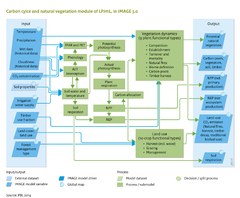Carbon cycle and natural vegetation: Difference between revisions
Jump to navigation
Jump to search
No edit summary |
No edit summary |
||
| Line 7: | Line 7: | ||
|Parameter=Soil properties - grid; | |Parameter=Soil properties - grid; | ||
|OutputVar=Potential natural vegetation - grid; NEP (net ecosystem production) - grid; Land-use CO2 emissions - grid; Carbon pools in vegetation - grid; NPP (net primary production) - grid; Soil respiration - grid; Carbon pools in soil and timber - grid; | |OutputVar=Potential natural vegetation - grid; NEP (net ecosystem production) - grid; Land-use CO2 emissions - grid; Carbon pools in vegetation - grid; NPP (net primary production) - grid; Soil respiration - grid; Carbon pools in soil and timber - grid; | ||
|Description=The terrestrial biosphere plays a key role in global and regional carbon cycles and thus in the climate system. Large amounts of carbon (between 2000 and 3000 PgC) are stored in the vegetation and soil components. Currently, the terrestrial biosphere absorbs about 30% of emitted CO2 ([[Ballantyne et al., 2012]]), and this carbon sink can be maintained and even enhanced by, for instance, protecting established forests and by establishing new forests ([[Van Minnen et al., 2008]]). However, deforestation and other land use changes in the last few centuries have contributed considerably to the build-up of atmospheric carbon dioxide ([[Van Minnen et al., 2009]]; [[Houghton, 2010]) and this trend is projected to continue [[(Müller et al., 2007]]). | |Description=The terrestrial biosphere plays a key role in global and regional carbon cycles and thus in the climate system. Large amounts of carbon (between 2000 and 3000 PgC) are stored in the vegetation and soil components. Currently, the terrestrial biosphere absorbs about 30% of emitted CO2 ([[Ballantyne et al., 2012]]), and this carbon sink can be maintained and even enhanced by, for instance, protecting established forests and by establishing new forests ([[Van Minnen et al., 2008]]). However, deforestation and other land use changes in the last few centuries have contributed considerably to the build-up of atmospheric carbon dioxide ([[Van Minnen et al., 2009]]; [[Houghton, 2010]]) and this trend is projected to continue [[(Müller et al., 2007]]). | ||
Regardless of land cover and land use, the net carbon sink in the terrestrial biosphere is affected by a range of environmental conditions such as climate, atmospheric CO2 concentration and moisture. These conditions influence processes that take up and release CO2 from the terrestrial biosphere such as photosynthesis, plant and soil respiration, transpiration, carbon allocation and turnover, and disturbances such as fires. | Regardless of land cover and land use, the net carbon sink in the terrestrial biosphere is affected by a range of environmental conditions such as climate, atmospheric CO2 concentration and moisture. These conditions influence processes that take up and release CO2 from the terrestrial biosphere such as photosynthesis, plant and soil respiration, transpiration, carbon allocation and turnover, and disturbances such as fires. | ||
Revision as of 10:39, 20 May 2014
Parts of Carbon cycle and natural vegetation
| Component is implemented in: |
|
| Related IMAGE components |
| Models/Databases |
| Key publications |
| References |
Key policy issues
- What is the role of the terrestrial biosphere in the global carbon cycle, how will it change in time as a result of climate and land-use change?
- To what extent can the terrestrial biosphere contribute to reducing the accumulation of CO2 in the atmosphere and what are viable mechanisms?
- What opportunities exist to reduce land-use related carbon emissions (e.g. REDD) and even enhance the carbon uptake through the establishment of new forests.
- What are the contributions of land-use change, climate change and CO2 fertilization on the future carbon cycle and how can these be considered in climate policies?
Introduction
